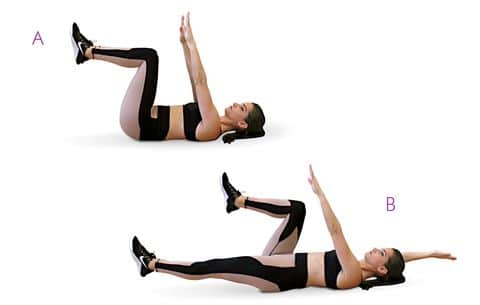 5-star Fitness
5-star Fitness
 5-star Fitness
5-star Fitness

Forget what you thought you knew about core exercises- we’re here to tell you how you can a strong core without crunches!
Tired of doing countless crunches and not getting the results you want for a strong core? Or, maybe you are trying to heal your diastasis recti (separation of your rectus abdominis muscle) and you need to avoid any crunching motion altogether! Either way, it is important to understand that your core is much more than the rectus abdominis muscle that makes up the show muscles we commonly refer to as a “6-pack”! So, let’s take a little time to get to know what makes up your ENTIRE core, and what exercises you need to do for a stable, strong core.
Your Core—It’s Way More Than a Six Pack!
It’s easy to think of your core as just those six muscles that make up that washboard ab look, but it’s so much more. Your core muscles provide precise stabilization to the spine and pelvis and make everyday activities, such as walking, running, and biking, possible. Core muscles include many deep and superficial muscles of the trunk including muscles of the abdomen, back, and pelvic floor. The central nervous system works with these muscles to control their timing of contraction to increase spinal stiffness before any movement. The superficial core muscles cross a larger region of the body, providing core stabilization and produce power from head to toe. When these muscles are not firing correctly, spinal stabilization is hindered and injuries such as low back pain and sacroiliac pain can occur. This is why stabilization exercises are important and much more beneficial than ordinary crunches.
The many muscles that make up your core include:
•DEEP STABILIZER MUSCLES:
-Transverse abdominis muscle (TVA)
-Multifidus muscles
-Internal obliques
-Diaphragm
-Pelvic floor muscles
•SUPERFICIAL STABILIZER MUSCLES:
-Rectus abdominis
-External obliques
-Erector spinae
-Quadratus lumborum
-Psoas major
Bye Bye Crunches!
Crunches involve repetitive spinal flexion, which can cause excessive strain on the discs and nerves between the vertebrae of your spine. This repetitive flexion motion can not only cause back pain (which is what we are trying to prevent!) but reinforce bad posture of the spine as well! When you are in a crunched position, your shoulders begin to round and your head moves forward—exactly how we look slumped over our desk all day! And, if you are trying to heal from diastasis recti, those crunches are going to cause your tummy to dome up and increase pressure on that already weakened area. One of the best rules of thumb to remember- you get what you train for most of the time! Now, when you’re sitting at your desk you’re not training your muscle, but chances are your posture is not perfect which means you’re reinforcing(training) bad habits of slouching. As previously mentioned, the slouching position is very similar to the crunching position, so if you’re trying to fix that problem, doing exercises that mimic a slouch is going to be a lot less helpful than those that oppose and challenge that familiar position.
Hello Core Stabilizations Exercises!
Core stabilization exercises will help keep your lower back happy by increasing the structural and functional efficiency of your core. Almost every exercise has a variation or modification you can implement to fit your personal fitness level as well as ways to increase the intensity and neuromuscular control… and honestly who doesn’t love that?! So, forget those crunches and add these fun and challenging core exercises to your workout instead for a stable and strong core!
Start with 3 sets of 12-15 reps for each exercise. If you are more advanced, go with 4 sets of 20 reps for each exercise! (If the exercise alternates sides of the body perform 12-15 sets each side!)
Dead Bug

Begin lying on your back with hands extended toward the ceiling. Bring feet, knees, and hips up to 90 degrees. Stabilize core by pulling in the belly button, pulling ribs down and towards each other, and pushing the small of your lower back into the ground beneath you. Hold this position throughout the movement. Start the exercise by extending the opposite leg and arm, straightening the knee and hip to bring the leg just a few inches above the ground. Maintain the position of your pelvis as you perform the movement, as your back is going to want to arch. Only go as low as your stability on your core allows. Return the working leg and arm to the starting position. Repeat on the opposite side, alternating until the set is complete.
Superman

Lie on your stomach on a mat or the floor with your legs outstretched and your arms out overhead. Relax your neck and align your head with your spine. Engage your core muscles to stabilize your spine and slowly raise your legs and arms a few inches off the floor. Hold for a few seconds then lower your legs and arms back to your starting position.
Bird-Dog

Start at a hands and knees position on an exercise mat with knees underneath hips and wrists directly underneath shoulders. Slowly raise and straighten the right arm and left leg until they both are at, or close to parallel, to the floor and hold for a few seconds. Keep the head aligned with the spine throughout the movement. Gently lower yourself back to your starting position. Change sides, maintaining balance and control.
Side Plank

Lie on your right side with your legs stacked one on top of the other. Engage your core muscles as you raise your torso coming and support yourself on your right forearm. Your right elbow is bent and should be directly under your shoulder. Your head should be aligned with your spine. Keep the abdominals engaged to brace the spine. Begin by holding for 10 seconds working your way up to one minute. Gently return yourself to your starting position. Repeat on the other side. Modify by bending leg closer to the floor at 90 degrees.